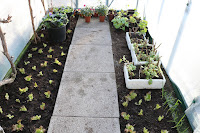GOOD
TIME TO PLANT ROSES
Roses have been in and out of
favour all my gardening life. I have always been a rose lover and
never had a garden without them, but just like fashion they have
their moments, then everything changes. Sixty years ago they were
very much in favour, but relatively expensive.
They were a means to
brighten up towns, and parks departments all over UK grew them and
planted them by the thousands. Aberdeen’s Anderson Drive was famous
for its roses and Dundee planted them in Parks and housing estates.
In my apprenticeship training we spent summer in Camperdown nursery
 |
| John waters climbing rose Dublin Bay |
 |
| Rose Dawn Chorus |
budding
thousands of roses. It was a great time, brilliant training and a lot
of fun. Roses were also used (the very vigorous and thorny types) as
barriers and hedgerows to prevent access in various places. In my
early years working in many parts of Scotland and England I always
bought a
hundred briar as rootstocks to
grow my own plants. Roses tended to suffer from mildew, blackspot,
rust and greenfly, but there was always a chemical to use to keep
these under control. Plant breeders were always bringing out new
varieties to try. Time has moved on and everything changes. Most
chemicals of yesterday are no longer in use, though there is still
some safe chemicals available to keep pests and diseases under
control. Plant breeders now look for diseases resistance for new
roses as most folk no longer bother to spray. Fashion in gardening
has also changed as the
younger
 |
| Rose Gaujard |
generation are less keen on
gardening, and as they all have one or two cars they need somewhere
to park them, so front gardens are disappearing. People now want easy
to maintain smaller gardens with permanent planting easy to look
after, so now roses are coming back into favour. Once planted in good
soil they can last for years if helped by some good pruning, and an
annual dressing of
fertiliser. Late winter is a
perfect time to order in roses as bare root plants, but today
interest in gardening for most folk begins in spring. At this time
garden centres are just packed with container grown roses all with
colourful labels, but if you wait a wee bit longer you can see them
in bloom when you can select your favourite colours and hopefully
some with a good rose scent. As these plants are permanent make
sure
the ground is well prepared in advance. For dedicated gardeners this
means double digging, especially if soil has a high clay content,
incorporating well rotted
 |
| Rose Myriam |
compost as digging proceeds,
but for others digging as deep as you can to help drainage will
always keep the bushes happy. Plant bushes at same depth as in pots
and for bare root bushes plant with crown at ground level. Suckers on
roses are no longer a problem as growers have changed
rootstocks to those that no
longer send up suckers. Cut new plants by about half after planting
to
encourage them to branch. Use
Floribunda and Hybrid Tea types for beds, shrub roses for bigger
borders and perimeter hedges and climbers to grow up walls. Pruning
of all types is usually aimed at replacing older wood with younger
wood, where ever possible.
Although
over time we all find our favourites, rose nurseries will always have
a few new varieties to try out every year. My criteria is always
firstly to see a good shaped flower with pleasing colour and scent
and must have healthy disease resistant foliage. I have bought a lot
of new roses in the past, only to dig them out a few years later as
disease wipes out the leaves. Last year was very dry early on so
mildew and greenfly became a huge problem, then the rain arrived and
forgot to go off, so blackspot and rust took over. Hopefully 2020
will be better. I’ve added a few photos of my
favourite bushes, E H Morse,
Dawn Chorus, Arthur Bell, shrubs Ispahan and climbers, Dublin Bay and
Gertrude Jekyll, but these can always change as new roses are tried
out.
Wee
jobs to do this week
 |
| Stored crops in February |
Check over fruit and
vegetables in store. Onions and pumpkins can store for months, but
apples need checking as some begin to shrivel, and potatoes begin to
sprout even in a cold garage as the mild weather keeps temperatures
too high for good storage. Parsnips, swedes and leeks are best left
in the ground and dug up as needed. Cabbage, sprouts and kale are
also just fine outdoors over winter. Kale putting on excellent top
growth in the mild winter.
END















































